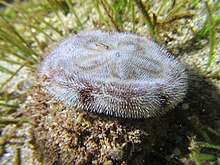Sand dollar
| Sand dollars | |
|---|---|

| |
| A live individual of Clypeaster reticulatus (Mayotte) | |
| Scientific classification | |
| Domain: | Eukaryota |
| Kingdom: | Animalia |
| Phylum: | Echinodermata |
| Class: | Echinoidea |
| Superorder: | Gnathostomata |
| Order: | Clypeasteroida |
The Sand dollars are species of flattened, burrowing sea urchins belonging to the order Clypeasteroida. Echinarachnius parma, the Common Sand Dollar, is widespread in the Northern Hemisphere, from the intertidal zone to considerable depths. Sand dollars can be found in temperate and tropical zones, but not in Great Britain.[2]p76
All sand dollars have a rigid skeleton known as a test. This is the typical white disk found washed up on beaches. The living animals have a skin of movable spines on the test. Movement is done by the action of the spines. Like other sea urchins, sand dollars have five paired rows of pores. The pores are arranged in a petal-like pattern. These pores are perforations in the endoskeleton through which the tube feet, used in gas exchange, project from the body.
Description[change | change source]

Living sand dollars have small spines covering its entire body. They are softer and much shorter than those of the sea urchin. Like all echinoderms, sand dollars have tube feet. They are not used to move around, but simply to breathe.[2] The sand dollar's tube feet actually stick out of the top of the sand dollar. On a sand dollar test, there is usually a pattern that looks like the petals of a flower. That pattern is made up of many tiny holes, and it is through these holes that the sand dollar's tube feet came out when it was alive.
A sand dollar uses its tiny spines to move around, and to dig into the sand. It often does this to bury itself in the sand. Sometimes, a sand dollar will only partially bury itself in the sand, and ends up poking up from the sand, standing on its side.
On the underside of a sand dollar, there is a star pattern spreading out from the center where the mouth is. This star pattern is made up of grooves that are called food grooves. Sand dollars filter sand and water, catching plankton and other things on their spines. Then, with cilia, the spines move the food into a food groove, and the food travels down the food groove to the mouth. Its food consists of crustacean larvae, small copepods, diatoms, algae and detritus.[3]
Life style[change | change source]
The sand dollars are the most specialised sea urchins. All their features are adaptations for burrowing. They live just beneath the sand, either flat or at an angle. At an angle they keep the edge facing the oncoming currents, presumably to catch food. This excellent habitat has been taken up by other groups of sea urchins. The heart urchins, another order, are even more effective in burrowing.[2]p76 Sand dollars can live for up to 10 years.
In 2008, biologists discovered that sand dollar larvae will clone themselves for a few different reasons. When a predator is near, certain species of sand dollar larvae will split themselves in half in a process they use to asexually clone themselves when they sense danger. The cloning process can take up to 24 hours and creates larvae that are 2/3 smaller than their original size which can help conceal them from the predator.[4] The larvae of these sand dollars clone themselves when they sense dissolved mucus from a predatory fish. The larvae exposed to this mucus from the predatory fish respond to the threat by cloning themselves. This process doubles their population and halves their size which allows them to better escape detection by the predatory fish but may make them more vulnerable to attacks from smaller predators like crustaceans. Sand dollars will also clone themselves during normal asexual reproduction. Larvae will undergo this process when food is plentiful or temperature conditions are optimal. Cloning may also occur to make use of the tissues that are normally lost during metamorphosis.
Colors[change | change source]
Most living sand dollars have dark colors, like brown or purple. Their darker color helps them stay camouflaged, easily hiding in the sand or mud or on the sea floor. The tests of sand dollars do not have bristles and tube feet, and because of the sun, they usually become bleached white.
References[change | change source]
- ↑ "The Paleobiology Database". Archived from the original on 2012-10-17. Retrieved 2024-04-06.
- ↑ 2.0 2.1 2.2 Nichols D. 1962. Echinoderms. Hutchinson, London. ISBN 0-09-065994-5
- ↑ Monterey Bay Aquarium: Online Field Guide
- ↑ Choi, Charles Q. (May 2008). "Split Defense". Scientific American. 298 (5): 38. Bibcode:2008SciAm.298e..38C. doi:10.1038/scientificamerican0508-38b – via Science Reference Center.
